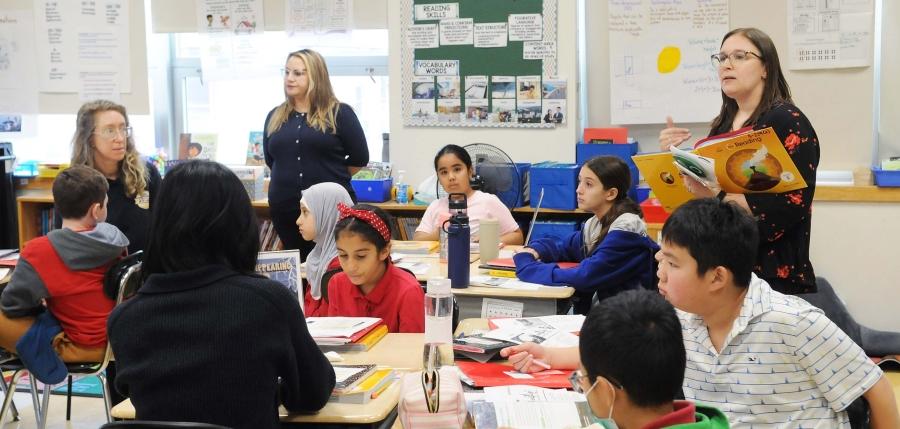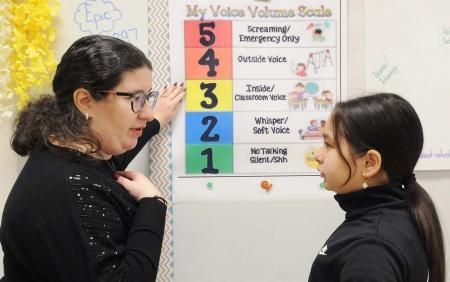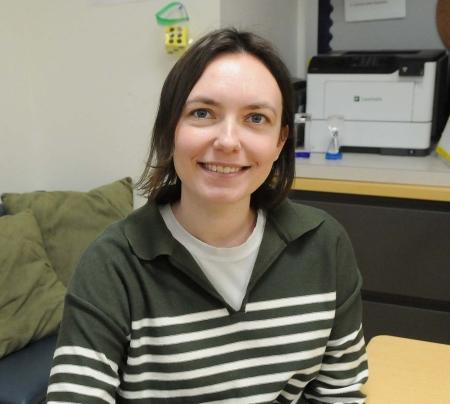A safe Nest for autistic students

Speech therapist Liza Trinkle (seated, left), paraprofessional Maria Lattanzi and co-teacher Sarah Harrow (right) are part of the educational team for their 5th-grade integrated co-teaching Nest class at PS 682 in Brooklyn.

Co-teacher Victoria Tanskaya discusses with her student a five-point volume scale, a Nest resource that is used schoolwide.
A 5th-grade class at PS 682 in Bensonhurst, Brooklyn is learning about earthquakes. They start by watching a video, with captions on, about an earthquake in Japan. One student walks to the front of the room and plops onto the floor to watch at closer range. Many train their eyes on the screen while their hands fiddle with fidget toys at their desks. A boy sits in a bean bag chair in the corner, quietly explaining to a speech therapist that he’s feeling overwhelmed.
After the video, a discussion ensues about earthquakes and the teachers move on to related vocabulary words. The student who was overwhelmed is, by now, listening intently from the bean bag chair. By the time the class has transitioned to a reading activity, he’s back at his desk.
The content is typical for a 5th-grade classroom, but modifications like the seating in the corner, freedom of movement, fidget devices and captions on the video are thanks to Nest, an innovative academic program in place at PS 682 and 82 other schools citywide that educates children with autism alongside their general education peers.
The program owes its success to the collaboration among teachers, administrators, speech therapists, occupational therapists and other related service providers.
“I work a lot with classroom teachers to find out what is challenging for these students in the classroom, then we focus on that in the therapy room,” said Liza Trinkle, a speech therapist at PS 682.
Trinkle, occupational therapist Sarah Canny and co-teachers Sarah Harrow and Victoria Tanskaya make up the educational team for this particular integrated co-teaching class of students with and without autism.
All their students have access to sensory tools, movement breaks, visual cues for school day transitions and other support strategies common in special education. Their students with autism also attend social groups with Trinkle, both inside and outside the classroom, where they work toward social and communication goals. Canny leads occupational therapy sessions privately with individual students and in small groups in the classroom. Her goals with students include “self-regulation, fine motor grasp and any adaptations they need, like slant boards for writing or pencil grips.”
Every week, the school’s related service providers meet with teachers from all grades participating in the Nest program to discuss students’ strengths and challenges and to propose support strategies. Trinkle pointed out that Nest is “probably one of the only programs” in the city with “built-in time to meet as a team.”
That common planning time results in consistency across settings. “Say we’re working on turn-taking in my smaller group,” she explained, then the classroom teachers will “set up a lesson to emphasize that skill,” using the same visuals that Trinkle introduced.
Nest began in 2003 as a pilot program in one Brooklyn school. The then-experimental model, designed through a partnership with New York University, was intended to address a lack of educational options for autistic students capable of doing grade-level work. At the time, students were limited to District 75 programs, more appropriate for children with greater needs, or general education programs with few services and little support for autism. Nest quickly became so popular that, 20 years later, it had expanded to 413 classrooms throughout the city.
Educators like those on the 5th-grade team at PS 682 say the Nest model reflects a shift from primarily behavioral-intervention goals (teaching students to mimic neurotypical, or nonautistic, behavior) to “neurodiversity-affirming” goals like self-advocacy.
“We’re trying to be their guest in the neurodiverse world and we’re trying to guide them about the mainstream world,” said Trinkle. Rather than coaching a student to, for example, sit still and make eye contact with an adult who is explaining something, Nest educators might help the student understand why the child’s preferred behavior, like pacing back and forth, could signal inattentiveness. The educator would then give the student the tools to explain “if I can pace while you talk, that helps me listen.”
The teachers and related service providers in a Nest classroom also help students find ways to modify their behaviors to fit their needs without distracting from a classroom environment. Harrow gave the example of the child who was “drawing and doodling nonstop, but drawing everywhere.” She first asked the student why he was drawing, and the student explained that it helps him focus, so Harrow provided a book specifically for classroom doodling. “We’re validating and encouraging the tool the child is using, but making it happen in a way that can facilitate instruction,” she said.
Neil Rathan, the UFT chapter leader at PS 682, says Nest has “created an all-hands-on-deck approach to learning about and supporting all children.”
The teachers, speech providers and occupational therapists in the Nest program, he said, “work so closely together to understand these children and provide the supports that they need to be successful. It’s organically created a collaborative culture throughout the school.”
By designing the classroom based on autistic students’ needs, Nest educators say they offer helpful tools to general education students while teaching them about inclusion and diversity.
In their 5th-grade classroom at PS 682, Tanskaya said, “everyone gets what they need to feel successful and learn — however that looks.”
